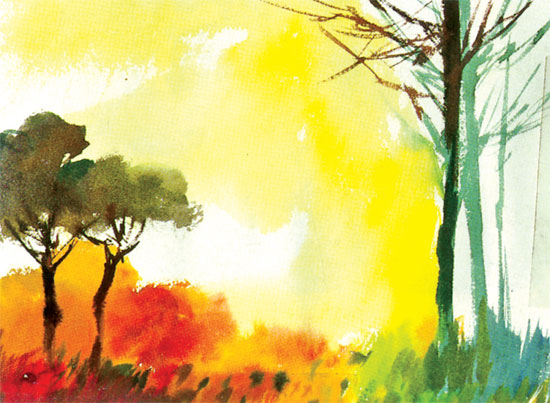|
Learn to draw by Tissa Hewavitarane:
Basic techniques
[Part 2]
Each artist and teacher has his own pet methods for getting students
started on watercolour, which seem to work best for him. There is no
single "best way" to get going. Teachers have to try several ways and
methods that seem to accomplish their purposes during the
'get-acquainted' period. Jumping directly into wet watercolour can often
produce fear, a feeling of helplessness; or reverting to grade school
practices. Several days or longer working with washing drawings,
stressing value contrasts and wet-in-wet techniques, is often valuable
in overcoming these problems.
|

A wash painting done with different tones. |
Line can be included in the process, or not, but the use of limited
values of wash tends to create the correct attitude towards the
transparent application of colour. Still lifes or student models make
excellent subject matter for such drawings and for later watercolours.
Keep the values limited to three plus black and work from lightest areas
to darkest.
Notice the effect of wet-into-wet areas, wet over dry, white space
left untouched and contrasts obtained by overlapping washes. Work
quickly and loosely to establish a painting quality. Explore methods of
stimulating textures by spattering or allowing drips to run the course.
Keep painting sessions relatively free of restrictions so that
exploration can take place and discoveries can be made. Succeeding steps
might involve the introduction of one or two colours, while keeping the
subject matter and work methods the same.
Apply colour washes over the three value ink wash drawings.
Substitute watercolours for the washes, but work in the same manner.
Keep the first palettes limited in colour and stress transparency,
overlapping and textural effects. Do not work initially for 'finished'
product, but take pleasure in the process and the exciting discoveries
that invariably take place.
Applying a loaded brush to paper is a delightful experience and
should be experienced for itself. Emphasis on water washes has to be
done rapidly to keep the tones of the wash even. Observe the painting
here. It is a watercolour wash. There are wet and vibrant areas in
various degrees.
In using brushes, young artists should learn at an early stage to use
the largest ones first - No. 10-12. Continue to use them as long as
possible in the painting process. Then go to a smaller size to paint
fine lines, such as No. 1,2 and 3. |

